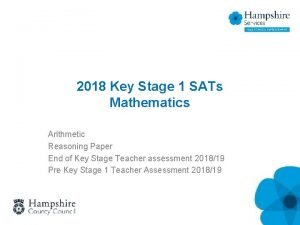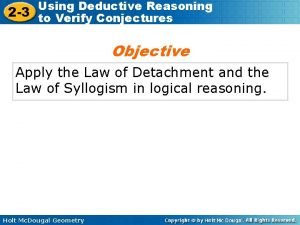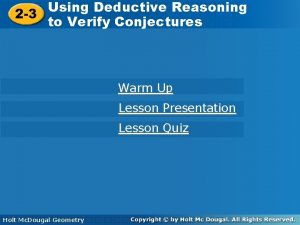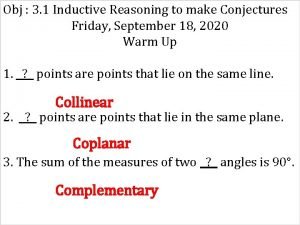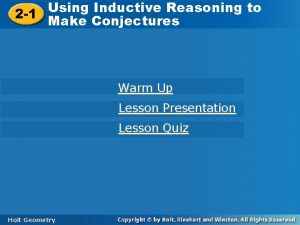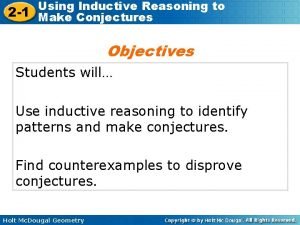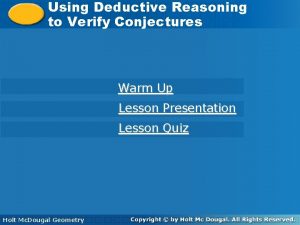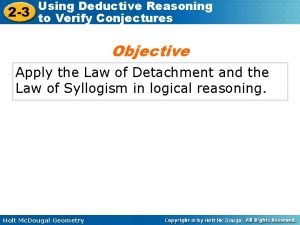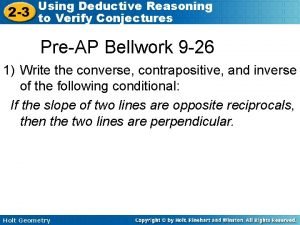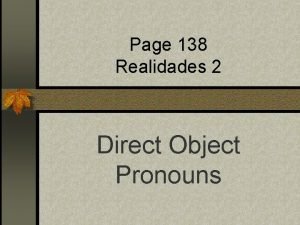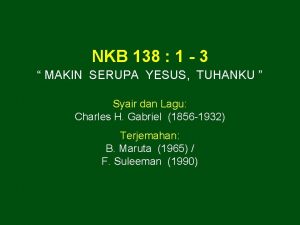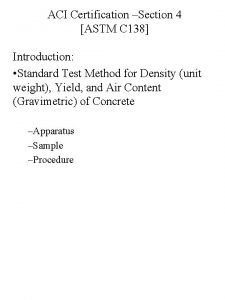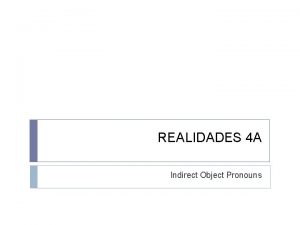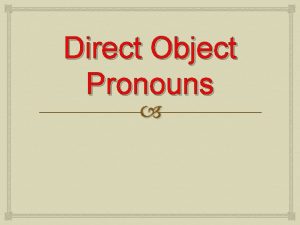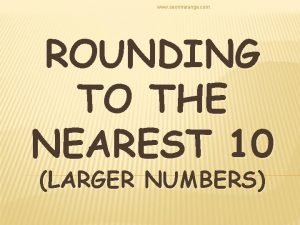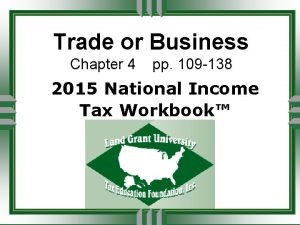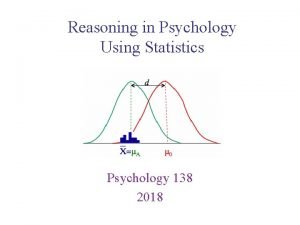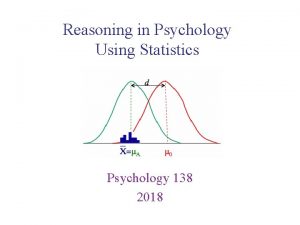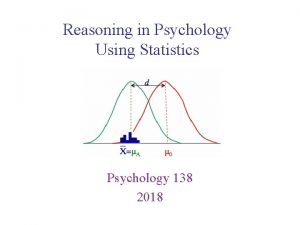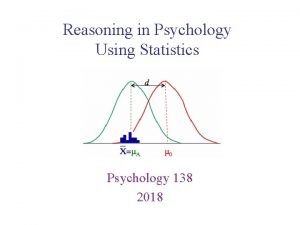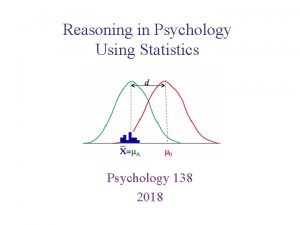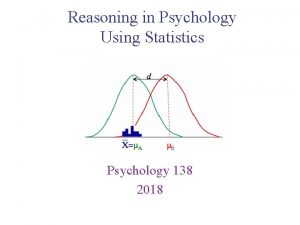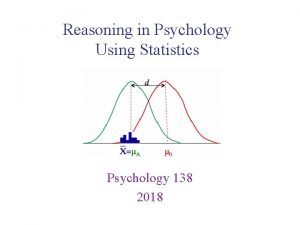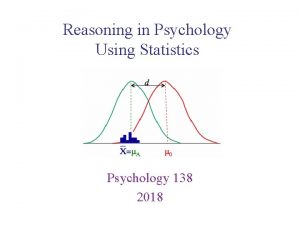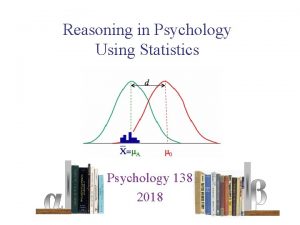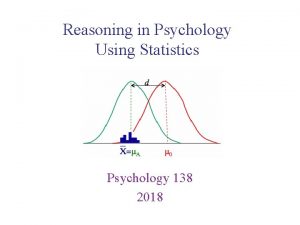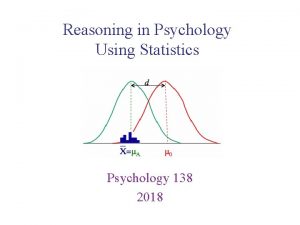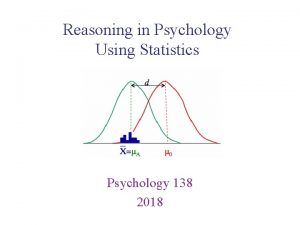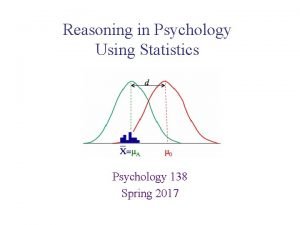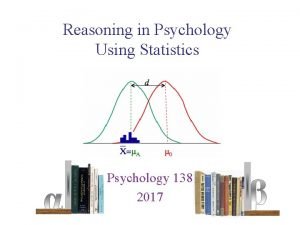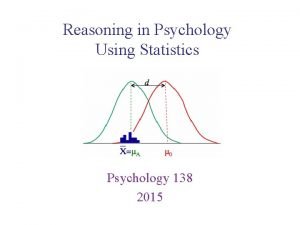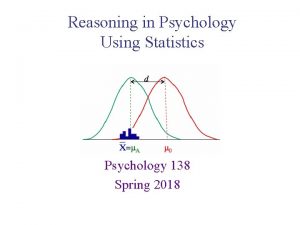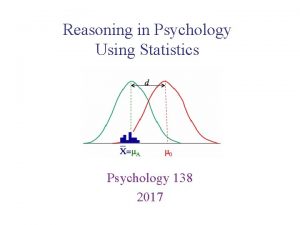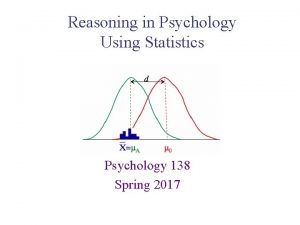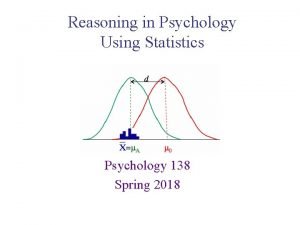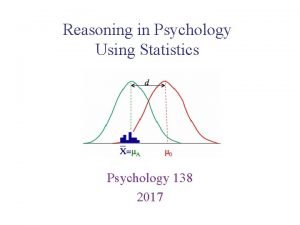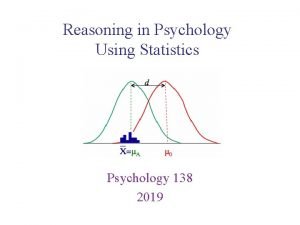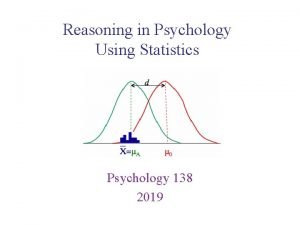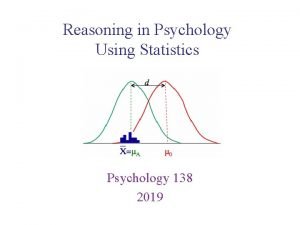Reasoning in Psychology Using Statistics Psychology 138 2018




































- Slides: 36

Reasoning in Psychology Using Statistics Psychology 138 2018

• Exam 2 in lecture and lab on Wednesday • Be prepared to do calculations (including square roots) on calculator Announcements Reasoning in Psychology Using Statistics

• We’d like to say: – • X causes Y To be able to do this: 1. The causal variable must come first 2. There must be co-variation between the two variables 3. Need to eliminate plausible alternative explanations Causal claims Reasoning in Psychology Using Statistics

• We’d like to say: – • X causes Y To be able to do this: 1. The causal variable must come first 2. There must be co-variation between the two variables 3. Need to eliminate plausible alternative explanations • Directionality Problem (temporal precedence): – Happy people sleep well - Or sleeping well makes you happy? Causal claims Reasoning in Psychology Using Statistics

• We’d like to say: – • X causes Y To be able to do this: 1. The causal variable must come first 2. There must be co-variation between the two variables 3. Need to eliminate plausible alternative explanations • Third Variable Problem: - Happy people sleep well - Or does sleeping well make you happy? Other • OR something else makes people happy and sleep well! Variable • Regular exercise • Minimal use of drugs & alcohol • Being a conscientious person • Being a good relationship Causal claims Reasoning in Psychology Using Statistics

• We’d like to say: – • X causes Y To be able to do this: 1. The causal variable must come first 2. There must be co-variation between the two variables 3. Need to eliminate plausible alternative explanations • Coincidence (random co-occurence) – r=0. 52 correlation between the number of republicans in US senate and number of sunspots » From Fun with correlations » See also Spurious correlations Causal claims Reasoning in Psychology Using Statistics Correlation is not causation blog posts: Internet’s favorite phrase Why we keep saying it

Descriptive Statistics - Statistical procedures to help organize, summarize & simplify large sets of data 1. One variable (frequency distribution) • Display results in a frequency distribution table & histogram (or bar chart if categorical variable). Make a deviations table to get measures of central tendency (mode, median, mean) & variability (range, standard deviation, variance). • 2. Two variables (bivariate distribution) • • 3. Display results: Make a scatterplot. Make a bivariate deviations or z-table to get Pearson’s r. Z-scores & normal distribution Review for Exam 2: Descriptive statistics Reasoning in Psychology Using Statistics

• Are hours sleeping related to GPA? – You conduct a survey. • Your sample of 10 gives these results for average hours per night sleeping: 7, 6, 7, 8, 8, 7, 9, 5, 9, 6 • You also have respondents give their overall GPA: 2. 4, 3. 9, 3. 5, 2. 8, 3. 0, 2. 1, 3. 9, 2. 9, 3. 6, 2. 7 – We will focus on sleep results first and then both variables together. • What kind of scales are they? • To find standard deviation, will we use formula for population or sample? Example Reasoning in Psychology Using Statistics

Hrs. sleep n=10 7, 6, 7, 8, 8 7, 9, 5, 9, 6 X 9 8 7 f p % cf c% 6 5 ∑ 10 1. 0 100 Step 1: Frequency distribution & histogram Reasoning in Psychology Using Statistics

Hrs. sleep n=10 7, 6, 7, 8, 8 7, 9, 5, 9, 6 ∑ X 9 8 7 f 2 2 3 6 5 2 1 10 p % cf c% 1. 0 100 Will enter first two columns as X and Y axes for frequency distribution Step 1: Frequency distribution & histogram Reasoning in Psychology Using Statistics

Hrs. sleep n=10 p = f/n ∑ X 9 8 7 f 2 2 3 p. 2. 2. 3 % 20 20 30 6 5 2 1 . 2. 1 20 10 10 cf c% 1. 0 100 Step 1: Frequency distribution & histogram Reasoning in Psychology Using Statistics

∑ X 9 8 7 f 2 2 3 p. 2. 2. 3 % 20 20 30 6 5 2 1 . 2. 1 20 10 10 cf c% 1 10 1. 0 100 Step 1: Frequency distribution & histogram Reasoning in Psychology Using Statistics

∑ X 9 8 7 f 2 2 3 p. 2. 2. 3 % 20 20 30 cf c% 6 5 2 1 . 2. 1 20 10 3 1 30 10 10 1. 0 100 Step 1: Frequency distribution & histogram Reasoning in Psychology Using Statistics

∑ X 9 8 7 f 2 2 3 p. 2. 2. 3 % 20 20 30 cf c% 6 60 6 5 2 1 . 2. 1 20 10 3 1 30 10 10 1. 0 100 Step 1: Frequency distribution & histogram Reasoning in Psychology Using Statistics

∑ X 9 8 7 f 2 2 3 p. 2. 2. 3 % 20 20 30 cf c% 8 6 80 60 6 5 2 1 . 2. 1 20 10 3 1 30 10 10 1. 0 100 Step 1: Frequency distribution & histogram Reasoning in Psychology Using Statistics

∑ X 9 8 7 f 2 2 3 p. 2. 2. 3 % 20 20 30 cf 10 8 6 c% 100 80 60 6 5 2 1 . 2. 1 20 10 3 1 30 10 10 1. 0 100 Step 1: Frequency distribution & histogram Reasoning in Psychology Using Statistics

Hrs. sleep X 9 8 7 f 2 2 3 6 5 2 1 F R E Q U E N C Y 6 5 4 3 2 1 5 6 7 8 9 SCORE Step 1: Frequency distribution & histogram Reasoning in Psychology Using Statistics

• Suppose that you combine two groups together. – How do you compute the new group mean? Group 1 110 110 Group 2 New Group 140 140 A weighted mean Reasoning in Psychology Using Statistics

• Suppose that you combine two groups together. – How do you compute the new group mean? Group 1 110 110 Group 2 New Group 140 140 A weighted mean Reasoning in Psychology Using Statistics Be careful computing the mean of this distribution, remember there are groups here X 9 8 7 f 2 2 3 6 5 2 1 9 9 8 8 7 7 7 6 6 5

Hrs. sleep n = 10 X 9 9 Create table, sorted in descending order 8 8 7 7 7 6 6 5 Step 2: Deviations table Reasoning in Psychology Using Statistics

X Hrs. sleep n = 10 9 9 8 8 7 7 7 6 6 5 ∑ 72 Step 2: Deviations table Reasoning in Psychology Using Statistics Mode = 7 (filled in) Median = 7 (arrow) Mean = (∑X)/n = 72/10 = 7. 2 Range = 5 to 9

X Hrs. sleep n = 10 ∑ 9 1. 8 8 . 8 7 -. 2 6 -1. 2 5 -2. 2 72 7. 2 0 = 9 -7. 2 Step 2: Deviations table Reasoning in Psychology Using Statistics Mode = 7 Median = 7 Mean = (∑X)/n = 72/10 = 7. 2 Range = 5 to 9

X Hrs. sleep n = 10 ∑ 9 1. 8 3. 24 = 1. 82 9 1. 8 3. 24 8 . 8 . 64 7 -. 2 . 04 6 -1. 2 1. 44 5 -2. 2 4. 84 72 7. 2 0 15. 6 = SS Step 2: Deviations table Reasoning in Psychology Using Statistics Mode = 7 Median = 7 Mean = ∑X/n = 72/10 = 7. 2 Range = 5 to 9 SD for sample = √ 15. 6/9 = √ 1. 73 = 1. 32

• The mean • The standard deviation – Change/add/delete a given score, then the mean will change. – Add/subtract a constant to each score, then the mean will change by adding(subtracting) that constant. – Add/subtract a constant to each score, then the standard deviation will NOT change. – Multiply (or divide) each score by a constant, then the mean will change by being multiplied by that constant. – Multiply (or divide) each score by a constant, then the standard deviation will change by being multiplied by that constant. Reasoning in Psychology Using Statistics Characteristics of a mean & standard deviation

Person A B C D E F G H I J Hrs. 7 6 7 8 8 7 9 5 9 6 GPA 2. 4 3. 9 3. 5 2. 8 3. 0 2. 1 3. 9 2. 9 3. 6 2. 7 G P A 4. 0 3. 5 3. 0 2. 5 2. 0 1. 5 1. 0 5 6 7 8 Hours of sleep Step 3: Scatterplot Reasoning in Psychology Using Statistics 9

Person A B C D E F G H I J Hrs. 7 6 7 8 8 7 9 5 9 6 GPA 2. 4 3. 9 3. 5 2. 8 3. 0 2. 1 3. 9 2. 9 3. 6 2. 7 G P A What does shape of envelope indicate about correlation? low positive correlation 4. 0 B 3. 5 3. 0 G C H 2. 5 I DE J 2. 0 A F 1. 5 1. 0 5 6 7 8 Hours of sleep Step 3: Scatterplot Reasoning in Psychology Using Statistics 9

Person A B C D E F G H I J K Hrs. 7 6 7 8 8 7 9 5 9 6 5 GPA 2. 4 3. 9 3. 5 2. 8 3. 0 2. 1 3. 9 2. 9 3. 6 2. 7 1. 0 What does shape of envelope indicate about correlation? moderate positive correlation G P A 4. 0 B 3. 5 3. 0 G C H 2. 5 I DE J 2. 0 A F 1. 5 1. 0 K 5 6 7 8 Hours of sleep Step 3: Scatterplot, Effect of outlier Reasoning in Psychology Using Statistics 9

Person A B C D E F G H I J K Hrs. 7 6 7 8 8 7 9 5 9 6 9 GPA 2. 4 3. 9 3. 5 2. 8 3. 0 2. 1 3. 9 2. 9 3. 6 2. 7 1. 0 What does shape of envelope indicate about correlation? low negative correlation G P A 4. 0 B 3. 5 3. 0 G C H 2. 5 I DE J 2. 0 A F 1. 5 1. 0 K 5 6 7 8 Hours of sleep Step 3: Scatterplot, Effect of outlier Reasoning in Psychology Using Statistics 9

X Y 9 1. 8 3. 24 3. 9 0. 82 0. 67 1. 476 9 1. 8 3. 24 3. 6 0. 52 0. 27 0. 936 8 0. 64 3. 0 -0. 08 0. 01 -0. 064 8 0. 64 2. 8 -0. 28 0. 86 -0. 224 7 -0. 2 0. 40 3. 5 0. 42 0. 18 -0. 084 7 -0. 2 0. 04 2. 4 -0. 68 0. 46 0. 136 7 -0. 2 0. 04 2. 1 -0. 98 0. 96 0. 196 6 -1. 2 1. 44 3. 9 0. 82 0. 67 -0. 984 6 -1. 2 1. 44 2. 7 -0. 38 0. 14 0. 456 5 -2. 2 4. 84 2. 9 -0. 18 0. 03 0. 396 0. 0 15. 6 30. 8 0. 0 3. 47 2. 24 SSX 3. 08 SSY SP Sum 72 Mean 7. 2 Step 4: Bivariate Deviations Table Reasoning in Psychology Using Statistics n=10 Note signs! +r or – r?

XY co-deviations ___2. 24___ = _2. 24_ =. 304 = √ 15. 6 * 3. 47 √ 54. 132 7. 357 X deviations, Y deviations Pearson’s r & summary statistics Reasoning in Psychology Using Statistics

SRA (Scientific Reasoning Assessment) (fictional) • Based on normative data: Normal, μ = 50. 0, σ = 10. 0 • Preparing for your analyses – Write down what you know – Make a sketch of the distribution (make a note: population or sample) 40 μ 60 An example Reasoning in Psychology Using Statistics – – Determine the shape What is best measure of center? What is best measure of variability? Mark the mean (center) and standard deviation on your sketch

SRA (Scientific Reasoning Assessment) (fictional) • Based on normative data: Normal distr. , μ = 50. 0, σ = 10. 0 • Question 1 • If George got a 35 on the SRA, what is his percentile rank? Unit Normal Table 0. 0668 40 -1. 0 m 60 1. 0 • Since a normal distribution, can use Unit Normal Table to infer percentile. That’s 6. 68% at or below this score (definition of percentile) z-scores & Normal Distribution Reasoning in Psychology Using Statistics

SRA (Scientific Reasoning Assessment) (fictional) • Based on normative data: Normal distr. , μ = 50. 0, σ = 10. 0 • Question 2 Unit Normal Table • What proportion of people get between a 40 and 60 on the SRA? 0. 1587 40 -1. 0 m 60 1. 0 That’s about 32% outside these two scores That leaves 68% between these two scores • Since a normal distribution, can use Unit Normal Table to infer percentile. z-scores & Normal Distribution Reasoning in Psychology Using Statistics

SRA (Scientific Reasoning Assessment) (fictional) • Based on normative data: Normal distr. , μ = 50. 0, σ = 10. 0 • Question 3 a transformation • Suppose that Chandra took a different reasoning assessment (the RSE: Based on normative data, Normal distr. , μ= 100, σ = 15). She received a 130 on the RSE. Assuming that they are highly positively correlated, what is the equivalent score on the SRA? z-scores & Normal Distribution Reasoning in Psychology Using Statistics

SRA (Scientific Reasoning Assessment) (fictional) • Based on normative data: Normal distr. , μ = 50. 0, σ = 10. 0 (for RSE) (for SRA) transformation • Question 3 a • Suppose that Chandra took a different reasoning assessment (the RSE: Based on normative data, Normal distr. , μ= 100, σ = 15). She received a 130 on the RSE. Assuming that they are highly positively correlated, what is the equivalent score on the SRA? z-scores & Normal Distribution Reasoning in Psychology Using Statistics

• In lab: continue to review, including SPSS • Questions? Wrap up Reasoning in Psychology Using Statistics
 Inductive v deductive reasoning
Inductive v deductive reasoning Deductive reasoning definition
Deductive reasoning definition Inductive reasoning definition
Inductive reasoning definition Inductive reasoning vs deductive reasoning
Inductive reasoning vs deductive reasoning Deductive method
Deductive method Patterns and inductive reasoning
Patterns and inductive reasoning Inductive method definition
Inductive method definition Arithmetic sats 2018
Arithmetic sats 2018 B a f c j e
B a f c j e Hashtags twitter statistics
Hashtags twitter statistics Global exhibition industry statistics 2018
Global exhibition industry statistics 2018 Introduction to statistics what is statistics
Introduction to statistics what is statistics Deductive
Deductive Using inductive reasoning to make conjectures
Using inductive reasoning to make conjectures 2-3 using deductive reasoning to verify conjectures
2-3 using deductive reasoning to verify conjectures Conjecture
Conjecture Making conjectures inductive reasoning
Making conjectures inductive reasoning Using inductive reasoning to make conjectures
Using inductive reasoning to make conjectures Using deductive reasoning to verify conjectures
Using deductive reasoning to verify conjectures Using deductive reasoning to verify conjectures
Using deductive reasoning to verify conjectures Using deductive reasoning to verify conjectures
Using deductive reasoning to verify conjectures Salmo 138 5
Salmo 138 5 Direct object pronouns (p. 138)
Direct object pronouns (p. 138) Makin serupa yesus tuhanku
Makin serupa yesus tuhanku Hkr 112 uitm
Hkr 112 uitm Double.object pronouns spanish
Double.object pronouns spanish P 138
P 138 Aci c138
Aci c138 Psalms 138:1-3
Psalms 138:1-3 Tiempo de orar salmo 138
Tiempo de orar salmo 138 Tec-138-702
Tec-138-702 Pg 138
Pg 138 Capítulo 4a indirect object pronouns (continued)
Capítulo 4a indirect object pronouns (continued) Direct object pronouns page 138 answers
Direct object pronouns page 138 answers Round 138 to the nearest ten
Round 138 to the nearest ten 109+138
109+138 Ps 138
Ps 138







